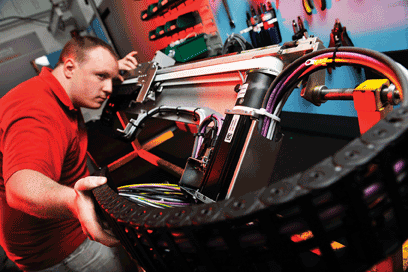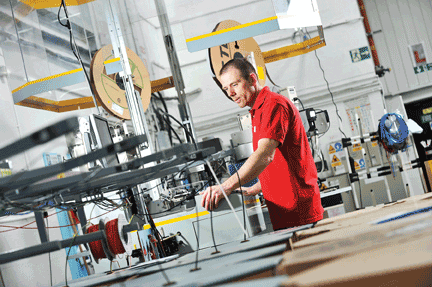It was a record-breaking year for industrial robots in 2011, with around 165,000 units sold worldwide — an increase of 37 per cent compared with 2010.
The first industrial robot was installed in 1961 by General Motors, and since then more than 2.3 million industrial robots have been sold globally.
General Motors’ Unimate was designed to transport die castings from an assembly line and perform spot welding — jobs that posed potential health risks to human workers at the plant.
Fast forward 51 years and the remit of the industrial robot — to perform repetitive or dangerous tasks to a consistently high standard — has remained largely unchanged, despite the technology becoming more capable and user friendly.

In 10 good reasons to invest in robots, ABB Robotics reiterates how machines such as Unimate and those that followed can help a business comply with safety rules and improve workplace health and safety.
Leading the charge towards automation through robotics, China, Germany and the US are cited by the International Federation of Robotics (IFR) as being responsible for robot sales growth rates of between 39 and 51 per cent in 2011.
China bought nearly 22,600 robots in 2011 and is predicted to overtake Japan and South Korea at the top of the worldwide robot market by 2014.
In most territories, automotive and metal are identified as the main drivers of growth
In most territories, automotive and metal are identified as the main drivers of growth — a situation mirrored in the UK, which recorded record sales in the first quarter of 2012 with 923 units.
According to the British Automation & Robot Association (BARA), automotive accounted for 85 per cent of this figure and concerns have been raised that other UK sectors risk falling behind overseas competitors because of their failure to invest in automation technologies that can bring down manufacturing costs, introduce flexibility in production and improve quality.
In a report entitled Automating manufacturing — ensuring the UK’s economic growth, the Engineering and Machinery Alliance (EAMA) cites statistics from IFR stating that Germany has an installed base of 144,100 industrial robots, Italy 62,200, France 34,100 and Spain 28,800, whereas the UK records 13,900.
A further report commissioned by members of the EAMA, with support from the UK Department for Business, Innovation and Skills (BIS) and BARA, identified the three main barriers to the take-up of robotic automation by Britain’s small and medium-sized enterprises.
Published in 2010 and entitled Application of automation in UK manufacturing, the study compared UK companies with those in Germany, Spain and Sweden and found that lack of awareness, reluctance to risk investment and a general shortage of skills hindered the uptake of automation technologies.

To rectify this, the government awarded BARA £600,000 in 2011 to roll out the Automating Manufacturing Programme (AMP). AMP was set up primarily to assist SMEs throughout Britain’s manufacturing sectors, but larger companies, with limited knowledge of and expertise in automation, are also eligible.
Chris Buxton, chief executive of BARA, told The Engineer that the programme was designed to raise awareness of the benefits of automation, provide education about the technology, offer totally impartial expert support and provide financial support.
A series of engagement programmes has been launched through seminars, a website (www.automatingmanufacturing.co.uk), mailshots and presentations. Roadshows are also held at sites that have successfully implemented automation in relation to their processes.
‘We’re trying every channel to market that we can,’ said Buxton. ‘Those interested in taking part are offered a manufacturing review and an independent expert assesses their facility, ending with the production of a report that identifies opportunities, if there are any, for automation. This does not cost the applicant.
‘If they wish, they can go on to an intervention or implementation support. That develops the opportunities from the initial review. It takes concept, budget, specifications and identification of potential suppliers and equipment types — again from an impartial expert. That is a maximum 20 days of support at a cost of £400 a day, 50 per cent funded. Basically, it’s £4,000 worth of free support.’
So far, around 203 companies have come forward for help from AMP, which Buxton said is well ahead of the targets set for the scheme, which ends in March 2013.
One company that has reaped the benefits of automation is PP Electrical Systems in Walsall. The company, which employs 210 staff, is engaged in the design and manufacture of electronic, electrical, electromechanical and electro-pneumatic assemblies for OEMs in industries including food processing, medical, pharmaceutical and power generation.
The company has 24 customers and a recent programme of investment has seen it spend £400,000 on specialist machinery from Artos.
‘The investment was put in place to give our customers, and their customers, the very highest levels of repeatable quality,’ said managing director Tony Hague.
‘You have two choices when you prepare cables: you invest heavily in automation to give you the highest repeatable quality or you do it by hand. You have a choice of people sitting there with cutters and strippers, hand fixing crimps and markers and literally prepping it all by hand, which is prone to error.
‘Different employees will use a tool differently; there’ll be different hand strengths. Then you’ve got the problem of RSI and the quality is very hit and miss. With the type of customers we’ve got, we cannot afford to have anything other than guaranteed, reliable electrical connections.’
Hague said the Artos machine has in-built automatic crimp force monitoring and is able to perform the measuring, crimping, cutting and stripping of cables. This capability removes the need for batch or sample testing and is 100 per cent reliable.
Hague said: ‘What’s the cost of an electric failure in a medical device? When you start to look at the cost of true quality, that’s when you realise that there’s no alternative than to offer best quality, which means the very best in automation technology.
‘We are considered to be one of the world’s most respected manufacturers in what we do. We’re a company in Walsall that’s grown from a local control systems builder employing 40 or 50 people to a world-leading provider of electrical control systems.
‘We would not have achieved that if we hadn’t invested in automation.’
Market outlook
Growth in robot use over the next five years is expected to result in the creation of one million high-quality jobs around the world
A study conducted by Metra Martech predicts that robotics will be a major driver for global job creation over the next five years.
Released in November 2011, the report states that one million industrial robots currently in operation have been directly responsible for the creation of close to three million jobs.
A growth in robot use over the next five years will result in the creation of one million high-quality jobs around the world as robots are expected to create jobs in industries including consumer electronics, food, solar and wind power and advanced battery manufacturing.
The report, titled Positive impact of industrial robots on employment, highlights that between 2000 and 2008 manufacturing employment increased in nearly every major industrialised country, even as the use of robotics increased sharply.
This same pattern is now being seen in China, Brazil and other emerging countries as they rapidly increase their use of robotics.




Project to investigate hybrid approach to titanium manufacturing
What is this a hybrid of? Superplastic forming tends to be performed slowly as otherwise the behaviour is the hot creep that typifies hot...